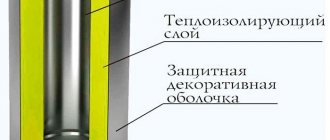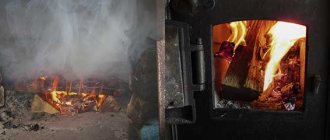Remedy for intoxication
Being a frequent phenomenon in cities, waste in the countryside is observed very often.
The reason for this lies in the imperfection of our stoves and in the desire to retain heat in the room by closing the chimney early. The same fumes are caused by smoldering coals in a brazier, iron stoves, etc.
The first signs of intoxication include headache, dizziness, darkening of the eyes, strong heartbeat and sometimes even fainting.
First aid consists of taking the burnt person out into the fresh air, wiping his face with cold water, and if there is snow on hand, then with snow. At the same time, they give him a sour drink inside: water with lemon, lemonade, etc.
If the intoxication is accompanied by fainting, then the patient is again taken out into the fresh air, their whole body is rubbed, they are sprinkled with cold water, they give him artificial respiration, they give him ammonia to sniff, in a word, they take all measures to bring the intoxicated person to his senses. If the patient begins to revive and becomes nauseous, they try to artificially induce vomiting. To do this, it is enough to irritate the root of the tongue with a finger or a feather. If there is severe redness of the face, apply 10-15 leeches to the anus.
When the distressed person is already able to swallow, they give him a little wine, sour drink, 5-6 drops of ammonia, tea, depending on what is at hand.
Usually the victim is left with a severe headache. To alleviate it, you need to apply hot poultices to your temples, trying, however, not to cause burns. In the same sense, rubbing with alcohol, vinegar or cologne is also useful.
How can you get poisoned?
The result of an ignition or fire is a gas-emulsion cloud that spreads in the air and consists of finely dispersed decay particles. Carbon monoxide and hydrocyanic acid are released. Carbon monoxide has the most severe health effects.
carbon monoxide
Smoke poisoning occurs due to the release of toxic substances into the atmosphere that enter the respiratory system. During a fire, carbon monoxide (carbon monoxide) is formed, it enters the body and blocks oxyhemoglobin. Oxyhemoglobin carries oxygen to human tissues and cells. Carbon smoke forms a strong bond with oxygen (carboxyhemoglobin) and blocks oxyhemoglobin. Carboxyhemoglobin is in excess and causes severe oxygen starvation, which leads to intoxication or death.
Cigarettes
Tobacco contains nicotine. The alkaloid is very toxic and addictive. Severe poisoning occurs with 20 smoked cigarettes, a lethal dose of 30 cigarettes. Long-term smoking causes chronic bronchitis, stomach ulcers, and hypertension.
Cigarette smoke poisoning is especially dangerous for children. If adults smoke in the room where the baby is, the child develops a chronic form of intoxication. In a growing body, there is a gradual accumulation of toxic and carcinogenic substances, which lead to tuberculosis, malignant lung tumors and diseases of the cardiovascular system.
Smoke from the fire
Smoke poisoning from a fire occurs due to the release of tars, which correspond to 40 smoked cigarettes. Particles enter through the respiratory tract, irritate the mucous surface and cause spasms. As a result, your health worsens, headaches appear, tearing, sore throat and cough increase.
Combustion of plastic objects, foam rubber, and paint coatings is especially dangerous for humans and the environment. The materials emit phosgene (a very toxic and asphyxiating gas with an unpleasant smell of old hay) and dioxin (a poisonous compound with a strong carcinogenic effect).
When construction materials burn, hydrocyanic acid (hydrogen cyanide) is formed. It emits a poisonous and irritating gas that penetrates the respiratory tract and skin. 0.005 g per 10 kg is enough. weight of a person to cause death.
Carbon monoxide poisoning. First aid for carbon monoxide poisoning
This product of incomplete combustion of various types of fuel, colorless and odorless, has a pronounced toxic effect.
In the old days, carbon monoxide (carbon monoxide) poisoning was common - closed the stove damper before the firewood burned, and fell asleep. and didn't wake up. This still happens in villages today. And with the expansion of dacha construction, the “process” went further. Car heaters also pose a significant danger: a couple dozed off in the cabin, numb from the heat. And car exhaust gases contain very large amounts of carbon monoxide.
This gas enters the human blood 200 times faster than oxygen. Special studies have established that carbon monoxide “takes over the initiative” from oxygen. It binds with hemoglobin several times easier and more actively, converting it into a chemical complex - carboxyhemoglobin. As a result, hemoglobin loses its ability to carry oxygen to tissues, especially to vital ones - the brain, lungs, heart. The lack of oxygen causes suffocation. Similar dysfunctions occur in cases of natural gas poisoning due to careless use of gas appliances.
Fortunately, lethal concentrations of gas do not form immediately, except in cases of industrial accidents.
Therefore, a person can determine the first symptoms of poisoning himself. Unless, of course, he is sleeping. What are these symptoms?
Symptoms of carbon monoxide poisoning
There is a feeling of heaviness and pulsation in the head, pain in the temples and forehead - the forehead, as they say, squeezes like a hoop, knocks in the temples, flashes in the eyes, and makes noise in the ears. Darkening begins in the eyes, trembling, weakness, palpitations, nausea, vomiting, and stupor appear. A person in such a situation intensively strives for fresh air. And he does the right thing! This is quite enough. Of course, you immediately need to ventilate the room or interior of the car and eliminate the source of the gas.
If a person remains in a gas-filled space, then consciousness becomes confused, drowsiness increases, followed by loss of consciousness. The pupils are dilated, breathing is shallow, the pulse is rapid, and convulsions occur. There is poisoning.
✏ If you witness such an incident, then immediately open the windows, doors, put out the fire, and fill it with water. Turn off electrical and gas appliances. Turn off the heater in the car and ventilate it. Remove or remove the victim to fresh air. Take a closer look at it and determine the degree of poisoning. If everything is limited to a dry cough, dizziness, increased heart rate, nausea or even vomiting, then you are on time. Unbutton your shirt collar, free your chest, and provide fresh air.
If the poisoned person’s condition has reached moderate severity and consciousness is clouded, bring a cotton swab moistened with ammonia or another irritating liquid (cologne, for example) to his nose, rub his chest, cover him with a blanket, give him hot coffee or tea. Remember: before losing consciousness, a person experiences excitement and may experience hallucinations. And then lethargy, apathy sets in, and pulls you to sleep.
Upon loss of consciousness, which already indicates severe poisoning, the victim’s skin turns red and the pupils dilate. Breathing, initially frequent and loud, becomes shallow. The person defecates involuntarily. But even if things have gone so far, one cannot despair. The salvation of the victim is in your hands. Immediately take it outside, and if you are unable to do this, open the window, or, as a last resort, break it. Place cold compresses or a heating pad with ice and a bottle of cold water on your head and chest. Give the cotton wool with ammonia a whiff.
If cardiac and respiratory activity drops, give injections of cordiamine, caffeine, ephedrine (2 ampoules each). If necessary, proceed to artificial respiration, and in case of cardiac arrest, to chest compressions. In case of severe carbon monoxide poisoning, when starting emergency care, call an ambulance.
✏ And don't forget about one more thing. If the victim has not lost consciousness, induce vomiting, then give him hot, strong tea or coffee.
There are old folk remedies and methods for intoxication
♦ Healers tried to induce vomiting not only with “two fingers in the mouth,” but also with a healing decoction. For this purpose, take 1 tbsp. a spoonful of coffin root (European coffin root is widespread in the middle zone of the European part of the country, in Western Siberia and the southeast, mainly in forest-steppe areas), placed in an enamel pan and poured with 300 ml of cold water, boiled for 15 minutes over low heat . The resulting mixture is filtered and given to the victim to drink 50 ml warm.
♦ In the old days, people used to put cold cranberries in their ears to combat intoxication; if there were no cranberries, they were successfully replaced with viburnum berries.
♦ The following method of saving the burnt was also common. In clean and fresh air, the victim was washed with cold water mixed with vinegar in a 1:1 ratio. This solution was given to the burnt person to drink at the rate of 100 ml per dose. Apparently, carbon dioxide bound and neutralized carbon monoxide.
Effect on the body
- CO enters the bloodstream 200 times faster than O2 and enters into active contact with hemoglobin in the blood. As a result, carboxyhemoglobin is formed - a substance that has a stronger bond with hemoglobin than oxyhemoglobin (oxygen combined with hemoglobin). This substance blocks the process of oxygen transfer to tissue cells, causing hemic hypoxia.
- CO binds to myoglobin (a protein in skeletal and cardiac muscle), reducing the pumping function of the heart and causing muscle weakness.
- In addition, carbon monoxide enters into oxidative reactions and disrupts the biochemical balance in tissues.
Carbon monoxide poisoning. First aid for carbon monoxide poisoning
This product of incomplete combustion of various types of fuel, colorless and odorless, has a pronounced toxic effect.
In the old days, carbon monoxide (carbon monoxide) poisoning was common - closed the stove damper before the firewood burned, and fell asleep. and didn't wake up. This still happens in villages today. And with the expansion of dacha construction, the “process” went further. Car heaters also pose a significant danger: a couple dozed off in the cabin, numb from the heat. And car exhaust gases contain very large amounts of carbon monoxide.
This gas enters the human blood 200 times faster than oxygen. Special studies have established that carbon monoxide “takes over the initiative” from oxygen. It binds with hemoglobin several times easier and more actively, converting it into a chemical complex - carboxyhemoglobin. As a result, hemoglobin loses its ability to carry oxygen to tissues, especially to vital ones - the brain, lungs, heart. The lack of oxygen causes suffocation. Similar dysfunctions occur in cases of natural gas poisoning due to careless use of gas appliances.
Fortunately, lethal concentrations of gas do not form immediately, except in cases of industrial accidents.
Therefore, a person can determine the first symptoms of poisoning himself. Unless, of course, he is sleeping. What are these symptoms?
Symptoms of carbon monoxide poisoning
There is a feeling of heaviness and pulsation in the head, pain in the temples and forehead - the forehead, as they say, squeezes like a hoop, knocks in the temples, flashes in the eyes, and makes noise in the ears. Darkening begins in the eyes, trembling, weakness, palpitations, nausea, vomiting, and stupor appear. A person in such a situation intensively strives for fresh air. And he does the right thing! This is quite enough. Of course, you immediately need to ventilate the room or interior of the car and eliminate the source of the gas.
If a person remains in a gas-filled space, then consciousness becomes confused, drowsiness increases, followed by loss of consciousness. The pupils are dilated, breathing is shallow, the pulse is rapid, and convulsions occur. There is poisoning.
✏ If you witness such an incident, then immediately open the windows, doors, put out the fire, and fill it with water. Turn off electrical and gas appliances. Turn off the heater in the car and ventilate it. Remove or remove the victim to fresh air. Take a closer look at it and determine the degree of poisoning. If everything is limited to a dry cough, dizziness, increased heart rate, nausea or even vomiting, then you are on time. Unbutton your shirt collar, free your chest, and provide fresh air.
If the poisoned person’s condition has reached moderate severity and consciousness is clouded, bring a cotton swab moistened with ammonia or another irritating liquid (cologne, for example) to his nose, rub his chest, cover him with a blanket, give him hot coffee or tea. Remember: before losing consciousness, a person experiences excitement and may experience hallucinations. And then lethargy, apathy sets in, and pulls you to sleep.
Upon loss of consciousness, which already indicates severe poisoning, the victim’s skin turns red and the pupils dilate. Breathing, initially frequent and loud, becomes shallow. The person defecates involuntarily. But even if things have gone so far, one cannot despair. The salvation of the victim is in your hands. Immediately take it outside, and if you are unable to do this, open the window, or, as a last resort, break it. Place cold compresses or a heating pad with ice and a bottle of cold water on your head and chest. Give the cotton wool with ammonia a whiff.
If cardiac and respiratory activity drops, give injections of cordiamine, caffeine, ephedrine (2 ampoules each). If necessary, proceed to artificial respiration, and in case of cardiac arrest, to chest compressions. In case of severe carbon monoxide poisoning, when starting emergency care, call an ambulance.
✏ And don't forget about one more thing. If the victim has not lost consciousness, induce vomiting, then give him hot, strong tea or coffee.
There are old folk remedies and methods for intoxication
Here are a few of them.
♦ Healers tried to induce vomiting not only with “two fingers in the mouth,” but also with a healing decoction. For this purpose, take 1 tbsp. a spoonful of coffin root (European coffin root is widespread in the middle zone of the European part of the country, in Western Siberia and the southeast, mainly in forest-steppe areas), placed in an enamel pan and poured with 300 ml of cold water, boiled for 15 minutes over low heat . The resulting mixture is filtered and given to the victim to drink 50 ml warm.
♦ In the old days, people used to put cold cranberries in their ears to combat intoxication; if there were no cranberries, they were successfully replaced with viburnum berries.
♦ The following method of saving the burnt was also common. In clean and fresh air, the victim was washed with cold water mixed with vinegar in a 1:1 ratio. This solution was given to the burnt person to drink at the rate of 100 ml per dose. Apparently, carbon dioxide bound and neutralized carbon monoxide.
Prevention
A little bit of theory
1. Use only working equipment
2. Make sure there is good ventilation
If you use a gas stove for heating, carbon monoxide poisoning is quite possible.
3. Do not close the stove damper until the coals have burned out
4. Car enthusiasts, do not start the engine in the garage for heating.
- dizziness, headache
- nausea, vomiting
- noise in ears
- shortness of breath, cough
- teary eyes.
Headache and dizziness are the most common symptoms of carbon monoxide poisoning.
If you have carbon monoxide poisoning, call an ambulance
- If chills begin or the temperature drops, wrap them up warmly and give them sweet tea (if the person is conscious, of course).
- Make yourself comfortable (and preferably in the fresh air or at least near an open window) to make breathing easier.
- Calm down if scared or agitated.
- Lay the unconscious person on his side and make sure that his head does not fall back, especially if vomiting suddenly occurs.
If breathing stops, artificial respiration should be done, and if the heart stops, indirect cardiac massage. BUT! These manipulations make sense only if you know how to perform them - otherwise there is a risk of causing even greater harm (although in general, it is reasonable for everyone who often travels outside the city to learn first aid skills - at the dacha, on a hike, fishing).
You can avoid the problem by following simple recommendations:
Quit smoking. In case of fire, immediately leave the premises and use protective equipment - respirators
Exercise caution when starting a fire. Replace gas stove pipelines in a timely manner
Do not forget to open the view when heating with a stove, or when visiting a bathhouse. Do not allow children to play with matches and lighters.
Practitioner. She graduated with honors from Vitebsk State Medical University in 2012 with a degree in general medicine. She was awarded a certificate of honor for her achievements in her work.
- Full recovery with possible temporary hearing loss.
- Recovery with persistent disturbances in the central nervous system
- Death due to heart and brain damage from lack of oxygen.
The main reasons for the accumulation of toxic substances
Carbon monoxide is extremely toxic if it enters the human body. It is much heavier than air and has neither color nor odor. That is why a person does not even feel at what point a poisonous gas begins to enter the body, which, combining with hemoglobin in the blood, prevents the flow of oxygen. What is the cause of carbon monoxide accumulation? The fact is that in a traditional Russian bath there must be a wood-burning stove, which is most often installed directly in the steam room. But when handling it, like any other heating device, you need to be extremely careful and adhere to the basic rules of operation.
What can be the main reasons for the release of carbon monoxide?
Actions
It is absolutely forbidden to ignore safety rules. Most often, a person in a bathhouse receives mild degrees of carbon monoxide poisoning. But still the consequences can be very dire, even fatal.
Poisoning occurs completely unnoticed by humans. In order not to get burned in the bathhouse during water procedures, you should take the rules for using the stove very seriously.
Diagnostics
If carbon monoxide is not recognized as the cause of symptoms, the problem may be misdiagnosed upon arrival at the emergency room.
Therefore, it is important to notify the emergency physician of your suspicions if you think CO is involved.
Making a diagnosis is relatively simple. It involves a noninvasive test with a device called a CO-oximeter, which is placed on a finger, toe, or other part of the body. The oximeter contains two diodes that emit light rays of different wavelengths. The amount of light absorbed by the tissue can tell doctors how much carboxyhemoglobin (a compound created by the bonding agent CO and hemoglobin) is in the blood.
Under normal circumstances, you would have less than 5 percent carboxyhemoglobin compared to free hemoglobin. Poisoning occurs if the level is between 10 and 30 percent. Death can occur at levels greater than 30 percent.
Regular pulse oximeters are useless because they cannot distinguish between carboxyhemoglobin and oxyhemoglobin (the compound formed when oxygen and hemoglobin bind).
Signs of poisoning in a bathhouse
A person, while in a bathhouse, cannot notice the flow of carbon monoxide into the room. And even signs of intoxication do not appear immediately. It is especially difficult to recognize the problem if the person drank alcohol before the steam room.
The main symptoms that indicate carbon monoxide poisoning are:
- dizziness;
- nausea;
- bitter taste in the mouth;
- headache;
- general weakness;
- vomit;
- dyspnea;
- loss of orientation;
- noise in ears;
- disturbance of visual perception.
And, besides this, experienced bathhouse attendants do not recommend being in the steam room yourself. After all, a person alone may not notice that he is receiving quite severe poisoning of the body. And there will be no one to help him.
Consequences
Any concentration of toxic substances can have a detrimental effect on the body, especially on brain performance. According to medical statistics, more than 40% of patients affected by gas, after a course of treatment, complained of memory impairment and frequent headaches. The consequences of poisoning are especially dangerous for people suffering from diseases of the cardiovascular system and the elderly.
The negative effects of exposure to toxic gas toxins may not appear immediately, but only after several weeks or months. According to the speed of manifestation, the consequences of poisoning are divided into two groups - early and late:
| Early complications (manifest after 2-3 days) | Late complications (manifest after 5-40 days) |
| Decreased hearing and vision | Development of amnesia |
| Poor blood circulation in the brain | Decreased mental capacity |
| Edema of the lungs, brain | Partial or complete blindness |
| Destabilization of heart rate | Cardiac asthma |
| Prolonged headaches | Pneumonia |
| Exacerbation of mental illnesses | Mental disorders |
First aid for carbon monoxide poisoning
In Russian baths with a non-electric stove there is always a chance of getting burned. Therefore, there should be no rush during bath procedures. All safety rules must be strictly followed. Be sure to listen to yourself and your feelings in the steam room to avoid trouble. If you feel that you are starting to feel dizzy and have a headache or that you are starting to feel sick in the bathhouse, you need to immediately leave the room for fresh air without waiting for your condition to worsen. You may have inhaled carbon monoxide and that is why you feel unwell.
Experts recommend warm tea or simply drinking plenty of fluids after leaving the room. But all this applies to mild degrees of poisoning. What to do if a person becomes very ill? The first step is to help the victim by taking him outside. If the person is unconscious, call an ambulance immediately. You need to take him out into the fresh air, let him breathe in ammonia and rub it on the burnt man’s temples. After this, make the person warm herbal tea.
What to do if ammonia does not help bring the victim to his senses? You need to do artificial respiration and wait for the ambulance. And be sure to remember that if a person does not regain consciousness, you need to put him on his side so that the tongue does not sink in and the person does not suffocate.
Stay close to the victim, monitor his pulse and breathing. Provide first aid and wait for the ambulance.
CO intoxication: obvious symptoms, irreversible consequences, risk groups and main causes
The severity of symptoms depends on the concentration of inhaled CO and the state of human health, mainly his respiratory, nervous and cardiovascular systems. Similar symptoms are typical when the concentration of inhaled CO reaches 0.052% for 1-5 hours. With greater concentration, the time for symptoms to appear decreases, and the first signs become more pronounced - severe headaches, nausea, vomiting, confusion, hallucinations.
The following symptoms are characteristic when CO concentrations are up to 0.094% for 1-2 hours, while the percentage of hemoglobin combined with carbon monoxide (carboxyhemoglobin - HbCO) is up to 20-40%:
- Severe headache, sometimes pulsating, accompanied by pressure in the temporal region;
- Dizziness, drowsiness, visual artifacts, lacrimation, confusion, hallucinations and tinnitus;
- Discomfort and pain in the chest, the appearance of shortness of breath, the development of tachypnea;
- Psycho-emotional instability, fears, memory loss, redness of the skin;
- Nausea, bouts of vomiting;
- Loss of movement coordination, ataxia.
With severe damage, fainting, tachycardia and other arrhythmias, Cheyne-Stokes breathing, convulsions, cramps, involuntary urination and defecation, deterioration of respiratory and cardiac function, and severe cyanosis appear.
Symptoms
To properly provide assistance for carbon dioxide poisoning, you need to know the characteristic symptoms.
Clear signs of mild carbon monoxide poisoning:
- migraine;
- tapping in the temporal area of the head;
- choking cough;
- severe dizziness;
- bouts of vomiting;
- nausea;
- tearfulness;
- severe pain in the chest area;
- hallucinations, both visual and auditory;
- purple color of the scalp;
- hypertension;
- tachycardia.
We invite you to familiarize yourself with the Machine for cinder blocks: drawings of the machine for do-it-yourself production, composition of the solution for production. The following symptoms indicate an average degree of intoxication:
- weakness;
- drowsiness;
- noise in ears;
- muscle paralysis.
The following signs indicate acute poisoning:
- fainting;
- uncontrolled urination and defecation;
- breathing problems;
- convulsions;
- cyanosis of the skin and mucous membranes;
- dilated pupils with poor reaction to light sources;
- coma.
Failure to provide assistance in a timely manner may result in death.
Carbon monoxide intoxication, alas, leaves behind a significant trace. In case of mild to moderate CO poisoning, a person may be bothered by:
- acute continuous headache;
- frequent dizziness;
- nervous disorders;
- memory loss;
- stop in development.
In acute poisoning, the following are often observed:
- circulatory disorders in the brain;
- polyneuritis;
- heart attack;
- cerebral edema;
- deterioration of hearing and vision (complete loss is possible);
- subarachnoid hemorrhage;
- severe pneumonia (with long-term coma).
Complications are unpredictable and often, unfortunately, lead to death.
At-risk groups
People who are particularly sensitive to carbon monoxide are:
- excessive consumption of alcoholic beverages;
- passionate about tobacco products;
- asthma sufferers;
- exhausted by nervous or physical stress.
Causes
Poisoning often occurs due to:
- faulty heating appliances used in bathhouses, houses, garages and apartments;
- violations of safety precautions for using a particular heating device;
- long stays in rooms that are not ventilated;
- presence of combustion products in the smoldering area;
- lack of good exhaust.
Besides these reasons, there are others, but these are the most common.
From the course of inorganic chemistry
Carbon monoxide, also known as carbon monoxide, chemical formula CO is a gas, colorless and odorless, under normal conditions it is lighter than air, it is extremely toxic, and according to the generally accepted classification it is classified as a highly toxic substance. Flammable
The toxicity of smoke emitted by burning fossil fuels, primarily coal, has been known for a very long time. So there are mentions of this in the works of Aristotle.
Its content is high in the exhaust gases of cars, primarily in obsolete gasoline internal combustion engines with a carburetor power system. Thus, such mechanisms can contain up to 3% carbon monoxide of the total volume in their exhaust gases, and in cases of incorrect operation of the power and ignition system, even more
At the same time, carbon monoxide is a very important raw material for the production of a number of synthetic organic alcohols. The food industry knows the technology of processing meat and meat products with this gas, as a result of which they acquire the attractive bright red color of a fresh product, without changing its taste.
Why are they poisoned by smoke?
Combustion products are gaseous, solid or liquid chemicals released during the process. The composition depends entirely on the item being burned. The most frequently formed harmful compounds are CO, SO2, CO2, P2O5. The atmosphere is literally saturated with vapors of acetone, alcohol, and carbon monoxide.
The most toxic are carbon monoxide and cyanide:
- The first interferes with the production of hemoglobin and the transport of O2.
- The second disrupts metabolism and does not allow oxygen to penetrate the tissues.
https://www.youtube.com/watch?v=wwN-xKAMT6M
Poisoning is possible when exposed to any substances released during combustion. However, extinguishing a fire is sometimes no less dangerous.
Common causes of intoxication:
- Some gases react with water, releasing toxic substances, such as nitric or sulfuric acid, ammonia. As a result, the mucous membranes of the lungs and bronchial tree are burned.
- Few people know, but sometimes extinguishing a fire with professional means provokes poisoning. Using a fire extinguisher when there is a fire in plastic, plastic, or rubber can lead to the formation of phosgene, which causes swelling of the respiratory system.
- It is easy to get poisoned by carbon monoxide when visiting a bathhouse, or from household poisoning when the stove pipeline is worn out.
- Damage is possible when the vehicle warms up. Oil distillation products, gasoline and diesel fuel, quickly saturate the air in a closed garage. In this case, the person falls asleep and cannot resist intoxication.
- The hidden threat is tobacco smoke. It doesn’t matter whether you develop an addiction to cigarettes or aesthetic hookah smoking, the lungs are equally affected.











